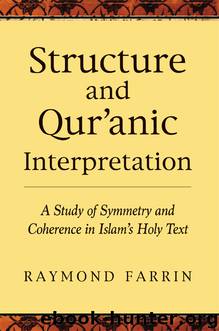Structure and Qur'anic Interpretation by Farrin Raymond;

Author:Farrin, Raymond; [Farrin, Raymond]
Language: eng
Format: epub
Publisher: White Cloud Press
Appendix B
Chapter Pairs
Below we indicate the chapter pairs occurring in the Qur’an, which total over fifty. With the exception of 43-44, 45-46, 47-48, and 63-64, these have all been previously identified by such scholars as Islahi, Mir, and Cuypers.1 For the sake of brevity, we identify here only certain correspondences and relationships in each of the pairs; in all likelihood, many more exist.
Chapters 2-3
Discussed in our third chapter above.
Chapters 4-5
These two long Medinan chapters both contain legislative sections and, following Chapters 2-3, continue to address the People of the Book. Examples of correspondences are the injunctions about marriage and dowries (4:4 and 5:5), the references to guidance for the People of the Book and their going astray (4:44 and 5:44), the statements about God’s bringing people together on the Day of Judgment and the comfort on that Day for various communities of believers (4:87 and 5:69), and the warnings about Satan (4:117-20 and 5:90-91). The chapters are also tied at their intersection by the description of the message as Light (4:174 and 5:15) and at their outer ends by the identification of God as Raqiib, Watcher (4:1 and 5:117).
Chapters 6-7
These two long late Meccan chapters are linked by the theme of the destruction of towns for disbelief. The theme is introduced early in Chapter 6 (vv. 6, 11), and it is repeated at the beginning of Chapter 7 (v. 4). Toward the middle of Chapter 6 (v. 92), there occurs a statement that the Qur’an is sent down as a blessed Book to the Prophet so that he may warn the Mother of Towns (Mecca) and those around her. Correspondingly, we find in a similar place in Chapter 7 (vv. 94, 96-98, 101) five statements and rhetorical questions about earlier, futile warnings by prophets to towns. Note also the connection between the opening praise of God and the closing description of exaltation by those near to Him (6:1 and 7:206).
Chapters 8-9
These two Medinan chapters were both revealed when the Muslim community was under threat, the former after the victory at Badr in 2/624, when the Quraysh of Mecca were gathering forces for a major counterattack, and the latter after the conquest of Mecca in 8/630, when Bedouin fighters to the south remained hostile and belligerency was expected from the Byzantines to the north. Both chapters exhort the Muslims to fight, but they also emphasize forgiveness and repentance (as in 8:38, and in the title of Chapter 9, Repentance). Examples of correspondences include the theme of going out to fight disbelievers (8:5 and 9:5), that of opposing the Prophet (8:13 and 9:13), and that of God’s helping the believers at Badr and at Hunayn southeast of Mecca (8:26 and 9:26). Also, the two chapters are tied at their ends by the references to the believers putting their trust in God (8:2 and 9:129).
Chapters 10-11
These two late Meccan chapters are both named after prophets (Jonah and Hud). Correspondences include the affirmations that people’s return is to God (10:4 and 11:4); the statements
Download
This site does not store any files on its server. We only index and link to content provided by other sites. Please contact the content providers to delete copyright contents if any and email us, we'll remove relevant links or contents immediately.
| Books & Reading | Comparative Literature |
| Criticism & Theory | Genres & Styles |
| Movements & Periods | Reference |
| Regional & Cultural | Women Authors |
4 3 2 1: A Novel by Paul Auster(12289)
The handmaid's tale by Margaret Atwood(7682)
Giovanni's Room by James Baldwin(7199)
Asking the Right Questions: A Guide to Critical Thinking by M. Neil Browne & Stuart M. Keeley(5651)
Big Magic: Creative Living Beyond Fear by Elizabeth Gilbert(5616)
Ego Is the Enemy by Ryan Holiday(5297)
The Body: A Guide for Occupants by Bill Bryson(4976)
On Writing A Memoir of the Craft by Stephen King(4864)
Ken Follett - World without end by Ken Follett(4647)
Adulting by Kelly Williams Brown(4489)
Bluets by Maggie Nelson(4478)
Eat That Frog! by Brian Tracy(4438)
Guilty Pleasures by Laurell K Hamilton(4362)
The Poetry of Pablo Neruda by Pablo Neruda(4041)
Alive: The Story of the Andes Survivors by Piers Paul Read(3970)
White Noise - A Novel by Don DeLillo(3955)
Fingerprints of the Gods by Graham Hancock(3943)
The Book of Joy by Dalai Lama(3904)
The Bookshop by Penelope Fitzgerald(3780)
